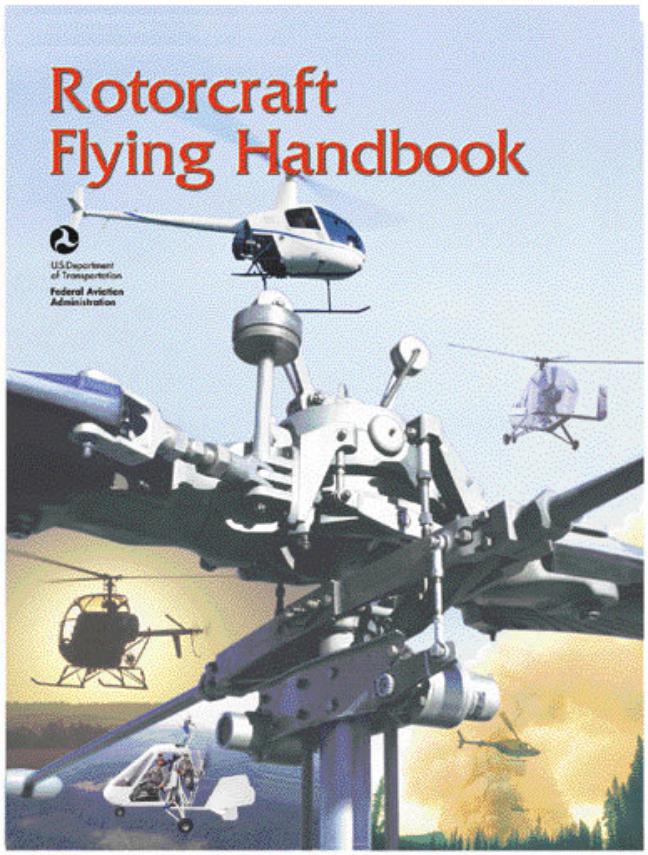
Rotorcraft Flying Handbook
.pdf

Front Matter.qxd 7/15/2003 2:25 PM Page i
ROTORCRAFT FLYING
HANDBOOK
2000
U.S. DEPARTMENT OF TRANSPORTATION FEDERAL AVIATION ADMINISTRATION
Flight Standards Service

Front Matter.qxd 7/15/2003 2:25 PM Page ii

Front Matter.qxd 7/15/2003 2:25 PM Page iii
PREFACE
The Rotorcraft Flying Handbook is designed as a technical manual for applicants who are preparing for their private, commercial, or flight instructor pilot certificates with a helicopter or gyroplane class rating. Certificated flight instructors may find this handbook a valuable training aid, since detailed coverage of aerodynamics, flight controls, systems, performance, flight maneuvers, emergencies, and aeronautical decision making is included. Topics, such as weather, navigation, radio navigation and communications, use of flight information publications, and regulations are available in other Federal Aviation Administration (FAA) publications.
This handbook conforms to pilot training and certification concepts established by the FAA. There are different ways of teaching, as well as performing flight procedures and maneuvers, and many variations in the explanations of aerodynamic theories and principles. This handbook adopts a selective method and concept to flying helicopters and gyroplanes. The discussion and explanations reflect the most commonly used practices and principles. Occasionally, the word “must” or similar language is used where the desired action is deemed critical. The use of such language is not intended to add to, interpret, or relieve a duty imposed by Title 14 of the Code of Federal Regulations (14 CFR). This handbook is divided into two parts. The first part, chapters 1 through 14, covers helicopters, and the second part, chapters 15 through 22, covers gyroplanes. The glossary and index
apply |
to |
both parts. |
|
It is essential for persons using this handbook to also become familiar with and apply the pertinent parts of 14 CFR and the Aeronautical Information Manual (AIM). Performance standards for demonstrating competence required for pilot certification are prescribed in the appropriate rotorcraft practical test standard.
This handbook supersedes Advisory Circular (AC) 61-13B, Basic Helicopter Handbook, dated 1978. In addition, all or part of the information contained in the following advisory circulars are included in this handbook: AC 90-87, Helicopter Dynamic Rollover; AC 90-95, Unanticipated Right Yaw in Helicopters; AC 91-32B, Safety in and around Helicopters; and AC 91-42D, Hazards of Rotating Propeller and Helicopter Rotor Blades.
This publication may be purchased from the Superintendent of Documents, U.S. Government Printing Office (GPO), Washington, DC 20402-9325, or from U.S. Government Bookstores located in major cities throughout the United States.
The current Flight Standards Service airman training and testing material and subject matter knowledge codes for all airman certificates and ratings can be obtained from the Flight Standards Services web site a t http://av-info.faa.gov.
Comments regarding this handbook should be sent to U.S. Department of Transportation, Federal Aviation Administration, Airman Testing Standards Branch, AFS-630, P.O. Box 25082, Oklahoma City, OK 73125.
AC 00-2, Advisory Circular Checklist, transmits the current status of FAA advisory circulars and other flight information publications. This checklist is free of charge and may be obtained by sending a request to U.S. Department of Transportation, Subsequent Distribution Office, SVC-121.23, Ardmore East Business Center, 3341 Q 75th Avenue, Landover, MD 20785.
AC00-2 also is available on the Internet at http://www.faa.gov/abc/ac-chklst/actoc.htm .

Front Matter.qxd 7/15/2003 2:25 PM Page iv

Front Matter.qxd 7/15/2003 2:25 PM Page v
CONTENTS
HELICOPTER
Chapter 1—Introduction to the Helicopter |
|
The Main Rotor System .................................. |
1-1 |
Fully Articulated Rotor System.................... |
1-1 |
Semirigid Rotor System .............................. |
1-2 |
Rigid Rotor System ..................................... |
1-2 |
Antitorque Systems ......................................... |
1-2 |
Tail Rotor ..................................................... |
1-2 |
Fenestron .................................................... |
1-2 |
NOTAR® ..................................................... |
1-2 |
Landing Gear................................................... |
1-2 |
Powerplant............................................................ |
|
1-3 |
|
Flight Controls ................................................. |
1-3 |
Chapter 2—General Aerodynamics |
|
Airfoil ............................................................... |
2-1 |
Relative Wind .............................................. |
2-2 |
Blade Pitch Angle ........................................ |
2-2 |
Angle of Attack ............................................ |
2-2 |
Lift.................................................................... |
2-3 |
Magnus Effect ............................................. |
2-3 |
Bernoulli’s Principle ..................................... |
2-3 |
Newton’s Third Law of Motion ..................... |
2-4 |
Weight ............................................................. |
2-4 |
Thrust .............................................................. |
2-5 |
Drag................................................................. |
2-5 |
Profile Drag ................................................. |
2-5 |
Induced Drag............................................... |
2-5 |
Parasite Drag .............................................. |
2-6 |
Total Drag.................................................... |
2-6 |
Chapter 3—Aerodynamics of Flight |
|
Powered Flight ................................................ |
3-1 |
Hovering Flight ................................................ |
3-1 |
Translating Tendency or Drift ...................... |
3-1 |
Pendular Action ........................................... |
3-2 |
Coning ......................................................... |
3-2 |
Coriolis Effect (Law of Conservation of |
|
Angular Momentum) .................................... |
3-2 |
Ground Effect .............................................. |
3-3 |
Gyroscopic Precession ............................... |
3-4 |
Vertical Flight................................................... |
3-4 |
Forward Flight ................................................. |
3-5 |
Translational Lift .......................................... |
3-5 |
Induced Flow ............................................... |
3-6 |
Transverse Flow Effect................................ |
3-6 |
Dissymmetry of Lift...................................... |
3-6 |
Sideward Flight................................................ |
3-8 |
Rearward Flight ............................................... |
3-8 |
Turning Flight .................................................. |
3-8 |
Autorotation ..................................................... |
3-8 |
Autorotation (Vertical Flight)........................ |
3-9 |
Autorotation (Forward Flight)..................... |
3-11 |
Chapter 4—Helicopter Flight Controls |
|
Collective Pitch Control ................................... |
4-1 |
Throttle Control................................................ |
4-1 |
Collective Pitch / Throttle Coordination ........... |
4-2 |
Correlator / Governor ...................................... |
4-2 |
Cyclic Pitch Control ......................................... |
4-2 |
Antitorque Pedals ............................................ |
4-3 |
Heading Control .......................................... |
4-3 |
Chapter 5—Helicopter Systems |
|
Engines ........................................................... |
5-1 |
Reciprocating Engine .................................. |
5-1 |
Turbine Engine ............................................ |
5-1 |
Compressor............................................. |
5-2 |
Combustion Chamber ............................. |
5-2 |
Turbine .................................................... |
5-2 |
Transmission System ...................................... |
5-3 |
Main Rotor Transmission ............................ |
5-3 |
Tail Rotor Drive System .............................. |
5-3 |
Clutch .......................................................... |
5-4 |
Centrifugal Clutch.................................... |
5-4 |
Belt Drive Clutch ..................................... |
5-4 |
Freewheeling Unit ................................... |
5-4 |
Main Rotor System.......................................... |
5-4 |
Fully Articulated Rotor System.................... |
5-4 |
Semirigid Rotor System .............................. |
5-5 |
Rigid Rotor System ..................................... |
5-5 |
Combination Rotor Systems ....................... |
5-5 |
Swash Plate Assembly................................ |
5-5 |
Fuel Systems................................................... |
5-6 |
Fuel Supply System .................................... |
5-6 |
Engine Fuel Control System ....................... |
5-6 |
Reciprocating Engines ............................ |
5-7 |
Carburetor ........................................... |
5-7 |
Carburetor Ice ..................................... |
5-7 |
Fuel Injection ....................................... |
5-8 |
Turbine Engines ...................................... |
5-8 |
Electrical Systems ........................................... |
5-8 |
Hydraulics ............................................................. |
|
5-9 |
|
Stability Augmentations Systems .................. |
5-10 |
Autopilot ........................................................ |
5-10 |
Environmental Systems................................. |
5-10 |
Anti-Icing Systems......................................... |
5-11 |
Chapter 6—Rotorcraft Flight Manual (Helicopter) Preliminary Pages ................................................
6-1

Front Matter.qxd 7/15/2003 2:25 PM Page vi
Operating Limitations ...................................... |
6-1 |
Airspeed Limitation...................................... |
6-1 |
Altitude Limitations ...................................... |
6-2 |
Rotor Limitations ......................................... |
6-2 |
Powerplant Limitations ................................ |
6-2 |
Weight and Loading Distribution ................. |
6-2 |
Flight Limitations ......................................... |
6-3 |
Placards............................................................ |
|
6-3 |
|
Emergency Procedures ................................... |
6-3 |
Normal Procedures ......................................... |
6-3 |
Performance .................................................... |
6-3 |
Weight and Balance ........................................ |
6-4 |
Aircraft and Systems Description .................... |
6-4 |
Handling, Servicing, and Maintenance............ |
6-4 |
Supplements ................................................... |
6-4 |
Safety and Operational Tips ............................ |
6-4 |
Chapter 7—Weight and Balance |
|
Weight ............................................................. |
7-1 |
Basic Empty Weight .................................... |
7-1 |
Useful Load ................................................. |
7-1 |
Payload............................................................. |
|
7-1 |
|
Gross Weight............................................... |
7-1 |
Maximum Gross Weight .............................. |
7-1 |
Weight Limitations ....................................... |
7-1 |
Determining Empty Weight ......................... |
7-1 |
Balance................................................................. |
|
7-2 |
|
Center of Gravity ......................................... |
7-2 |
CG Forward of Forward Limit ................. |
7-2 |
CG Aft of Aft Limit.................................... |
7-2 |
Lateral Balance ........................................... |
7-3 |
Weight and Balance Calculations ................... |
7-3 |
Reference Datum ........................................ |
7-3 |
Arm.............................................................. |
7-4 |
Moment............................................................. |
|
7-4 |
|
Center of Gravity Computation ................... |
7-4 |
Weight and Balance Methods ......................... |
7-4 |
Computational Method ................................ |
7-4 |
Loading Chart Method................................. |
7-5 |
Sample Problem 1 .................................. |
7-5 |
Sample Problem 2 .................................. |
7-5 |
Sample Problem 3 .................................. |
7-6 |
Combination Method ................................... |
7-6 |
Calculating Lateral CG ................................ |
7-7 |
Chapter 8—Performance |
|
Factors Affecting Performance ........................ |
8-1 |
Density Altitude ........................................... |
8-1 |
Atmospheric Pressure................................. |
8-1 |
Altitude ........................................................ |
8-2 |
Temperature ................................................ |
8-2 |
Moisture (Humidity) ..................................... |
8-2 |
High and Low Density Altitude Conditions |
..8-2 |
Weight ......................................................... |
8-2 |
Winds .......................................................... |
8-2 |
Performance Charts ........................................ |
8-3 |
Hovering Performance ................................ |
8-3 |
Sample Problem 1 .................................. |
8-4 |
Sample Problem 2 .................................. |
8-4 |
Takeoff Performance ................................... |
8-5 |
Sample Problem 3 .................................. |
8-5 |
Climb Performance ..................................... |
8-5 |
Sample Problem 4 .................................. |
8-6 |
Chapter 9—Basic Flight Maneuvers |
|
Preflight ........................................................... |
9-1 |
Minimum Equipment Lists (MELS) and |
|
Operations With Inoperative Equipment ..... |
9-1 |
Engine Start and Rotor Engagement .............. |
9-2 |
Rotor Safety Considerations ....................... |
9-2 |
Safety In and Around Helicopters ............... |
9-3 |
Ramp Attendants and Aircraft |
|
Servicing Personnel ................................ |
9-3 |
Aircraft Servicing ..................................... |
9-3 |
External-Load Riggers ............................ |
9-3 |
Pilot at the Flight Controls....................... |
9-3 |
External-Load Hookup Personnel ........... |
9-3 |
Passengers ............................................. |
9-4 |
Vertical Takeoff to a Hover .............................. |
9-5 |
Technique .................................................... |
9-5 |
Common Errors........................................... |
9-5 |
Hovering .......................................................... |
9-5 |
Technique .................................................... |
9-5 |
Common Errors........................................... |
9-5 |
Hovering Turn.................................................. |
9-6 |
Technique .................................................... |
9-6 |
Common Errors........................................... |
9-7 |
Hovering—Forward Flight ............................... |
9-7 |
Technique .................................................... |
9-7 |
Common Errors........................................... |
9-7 |
Hovering—Sideward Flight.............................. |
9-7 |
Technique .................................................... |
9-7 |
Common Errors........................................... |
9-8 |
Hovering—Rearward Flight ............................. |
9-8 |
Technique .................................................... |
9-8 |
Common Errors........................................... |
9-8 |
Taxiing ............................................................. |
9-8 |
Hover Taxi ................................................... |
9-9 |
Air Taxi......................................................... |
9-9 |
Technique ................................................ |
9-9 |
Common Errors....................................... |
9-9 |
Surface Taxi................................................. |
9-9 |
Technique ................................................ |
9-9 |
Common Errors..................................... |
9-10 |
Normal Takeoff From a Hover ....................... |
9-10 |

Front Matter.qxd 7/15/2003 2:25 PM Page vii
Technique .................................................. |
9-10 |
Common Errors......................................... |
9-10 |
Normal Takeoff From the Surface ................. |
9-11 |
Technique .................................................. |
9-11 |
Common Errors ......................................... |
9-11 |
Crosswind Considerations |
|
During Takeoffs.......................................... |
9-11 |
Straight-and-Level Flight ............................... |
9-12 |
Technique .................................................. |
9-12 |
Common Errors......................................... |
9-12 |
Turns ............................................................. |
9-12 |
Technique .................................................. |
9-12 |
Slips ........................................................... |
9-13 |
Skids ................................................................. |
|
9-13 |
|
Common Errors......................................... |
9-13 |
Normal Climb................................................. |
9-13 |
Technique .................................................. |
9-13 |
Common Errors......................................... |
9-14 |
Normal Descent............................................. |
9-14 |
Technique .................................................. |
9-14 |
Common Errors......................................... |
9-14 |
Ground Reference Maneuvers...................... |
9-14 |
Rectangular Course .................................. |
9-14 |
S-Turns ............................................................. |
|
9-16 |
|
Turns Around a Point ................................ |
9-17 |
Common Errors During Ground |
|
Reference Maneuvers ............................... |
9-18 |
Traffic Patterns .............................................. |
9-18 |
Approaches ................................................... |
9-19 |
Normal Approach to a Hover..................... |
9-19 |
Technique .............................................. |
9-19 |
Common Errors..................................... |
9-19 |
Normal Approach to the Surface............... |
9-20 |
Technique .............................................. |
9-20 |
Common Errors..................................... |
9-20 |
Crosswind During Approaches.................. |
9-20 |
Go-Around ..................................................... |
9-20 |
After Landing and Securing........................... |
9-20 |
Noise Abatement Procedures ....................... |
9-20 |
Chapter 10—Advanced Maneuvers |
|
Reconnaissance Procedures ........................ |
10-1 |
High Reconnaissance ............................... |
10-1 |
Low Reconnaissance ................................ |
10-1 |
Ground Reconnaissance........................... |
10-1 |
Maximum Performance Takeoff..................... |
10-2 |
Technique .................................................. |
10-2 |
Common Errors......................................... |
10-2 |
Running/Rolling Takeoff ................................ |
10-2 |
Technique .................................................. |
10-3 |
Common Errors......................................... |
10-3 |
Rapid Deceleration (Quick Stop)................... |
10-3 |
Technique .................................................. |
10-3 |
Common Errors......................................... |
10-4 |
Steep Approach to a Hover ........................... |
10-4 |
Technique .................................................. |
10-4 |
Common Errors......................................... |
10-5 |
Shallow Approach and Running/Roll-On |
|
Landing................................................................. |
|
10-5 |
|
Technique .................................................. |
10-5 |
Common Errors......................................... |
10-5 |
Slope Operations........................................... |
10-6 |
Slope Landing ........................................... |
10-6 |
Technique ............................................. |
10-6 |
Common Errors .................................... |
10-6 |
Slope Takeoff ............................................. |
10-6 |
Technique ............................................. |
10-7 |
Common Errors .................................... |
10-7 |
Confined Area Operations............................. |
10-7 |
Approach................................................... |
10-7 |
Takeoff....................................................... |
10-8 |
Common Errors......................................... |
10-8 |
Pinnacle and Ridgeline Operations............... |
10-8 |
Approach and Landing.............................. |
10-8 |
Takeoff....................................................... |
10-9 |
Common Errors......................................... |
10-9 |
Chapter 11—Helicopter Emergencies |
|
Autorotation ................................................... |
11-1 |
Straight-in Autorotation .............................. |
11-2 |
Technique.............................................. |
11-2 |
Common Errors..................................... |
11-3 |
Power Recovery From Practice |
|
Autorotation ............................................... |
11-3 |
Technique.............................................. |
11-3 |
Common Errors..................................... |
11-3 |
Autorotation With Turns ............................. |
11-3 |
Technique.............................................. |
11-3 |
Power Failure in a Hover........................... |
11-4 |
Technique.............................................. |
11-4 |
Common Errors..................................... |
11-4 |
Height/Velocity Diagram ................................ |
11-4 |
The Effect of Weight Versus |
|
Density Altitude.......................................... |
11-5 |
Vortex Ring State (Settling With Power)........ |
11-5 |
Retreating Blade Stall .................................... |
11-6 |
Ground Resonance ....................................... |
11-7 |
Dynamic Rollover .......................................... |
11-7 |
Critical Conditions...................................... |
11-8 |
Cyclic Trim ................................................. |
11-8 |
Normal Takeoffs and Landings.................. |
11-8 |
Slope Takeoffs and Landings .................... |
11-8 |
Use of Collective ....................................... |
11-9 |
Precautions................................................ |
11-9 |
Low G Conditions and Mast Bumping......... |
11-10 |
Low Rotor RPM and Blade Stall.................. |
11-10 |
Recovery From Low Rotor RPM ................. |
11-10 |

Front Matter.qxd 7/15/2003 2:25 PM Page viii
Systems Malfunctions.................................. |
11-11 |
Antitorque System Failure ....................... |
11-11 |
Landing—Stuck Left Pedal.................. |
11-11 |
Landing—Stuck Neutral or |
|
Right Pedal.......................................... |
11-12 |
Unanticipated Yaw / Loss of Tail Rotor |
|
Effectiveness (LTE) ................................. |
11-12 |
Main Rotor Disc Interference |
|
(285-315°)................................................ |
11-12 |
Weathercock Stability |
|
(120-240°)................................................ |
11-13 |
Tail Rotor Vortex Ring State |
|
(210-330°)................................................ |
11-13 |
LTE at Altitude..................................... |
11-13 |
Reducing the Onset of LTE ................. |
11-13 |
Recovery Technique ........................... |
11-14 |
Main Drive Shaft Failure.......................... |
11-14 |
Hydraulic Failures .................................... |
11-14 |
Governor Failure ..................................... |
11-14 |
Abnormal Vibrations ................................ |
11-14 |
Low Frequency Vibrations .................. |
11-15 |
Medium and High Frequency |
|
Vibrations............................................. |
11-15 |
Tracking and Balance ......................... |
11-15 |
Flight Diversion............................................ |
11-15 |
Lost Procedures .......................................... |
11-16 |
Emergency Equipment and Survival Gear .. |
11-16 |
Chapter 12—Attitude Instrument Flying |
|
Flight Instruments ................................................. |
|
12-1 |
|
Pitot-Static Instruments ............................. |
12-1 |
Airspeed Indicator................................. |
12-1 |
Instrument Check.................................. |
12-1 |
Altimeter................................................ |
12-2 |
Instrument Check.............................. |
12-2 |
Vertical Speed Indicator ............................ |
12-2 |
Instrument Check.................................. |
12-2 |
System Errors ....................................... |
12-2 |
Gyroscopic Instruments ............................ |
12-3 |
Attitude Indicator ................................... |
12-3 |
Heading Indicator.................................. |
12-3 |
Turn Indicators ...................................... |
12-4 |
Instrument Check.................................. |
12-4 |
Magnetic Compass ................................... |
12-4 |
Compass Errors .................................... |
12-4 |
Magnetic Variation ................................ |
12-4 |
Compass Deviation........................... |
12-5 |
Magnetic Dip ..................................... |
12-5 |
Instrument Check.............................. |
12-5 |
Instrument Flight............................................ |
12-5 |
Instrument Cross-Check ........................... |
12-5 |
Instrument Interpretation ........................... |
12-6 |
Aircraft Control .......................................... |
12-7 |
Straight-and-Level Flight ........................... |
12-7 |
Pitch Control ......................................... |
12-7 |
Attitude Indicator ............................... |
12-8 |
Altimeter............................................ |
12-8 |
Vertical Speed Indicator .................... |
12-8 |
Airspeed Indicator ............................. |
12-9 |
Bank Control ......................................... |
12-9 |
Attitude Indicator ............................... |
12-9 |
Heading Indicator............................ |
12-10 |
Turn Indicator .................................. |
12-10 |
Common Errors During |
|
Straight-and-Level Flight ..................... |
12-10 |
Power Control During |
|
Straight-and-Level Flight ..................... |
12-11 |
Common Errors During |
|
Airspeed Changes............................... |
12-11 |
Straight Climbs (Constant Airspeed |
|
and Constant Rate) ................................. |
12-11 |
Entry ................................................... |
12-12 |
Leveloff ............................................... |
12-14 |
Straight Descents (Constant Airspeed and |
|
Constant Rate) ........................................ |
12-14 |
Entry ................................................... |
12-14 |
Leveloff ............................................... |
12-15 |
Common Errors During |
|
Straight Climbs and Descents ............. |
12-15 |
Turns ....................................................... |
12-15 |
Turns to a Predetermined Heading .... |
12-16 |
Timed Turns ........................................ |
12-16 |
Change of Airspeed in Turns .......... |
12-16 |
30° Bank Turn ..................................... |
12-17 |
Climbing and Descending Turns......... |
12-17 |
Compass Turns................................... |
12-17 |
Common Errors During Turns............. |
12-18 |
Unusual Attitudes .................................... |
12-18 |
Common Errors During Unusual |
|
Attitude Recoveries ............................. |
12-18 |
Emergencies ............................................... |
12-18 |
Autorotations ........................................... |
12-19 |
Common Errors During |
|
Autorotations ....................................... |
12-19 |
Servo Failure ........................................... |
12-19 |
Instrument Takeoff ....................................... |
12-19 |
Common Errors During |
|
Instrument Takeoffs ................................. |
12-20 |
Chapter 13—Night Operations |
|
Night Flight Physiology.................................. |
13-1 |
Vision in Flight........................................... |
13-1 |
The Eye ............................................................ |
|
13-1 |
|
Cones ........................................................ |
13-1 |
Rods ................................................................. |
|
13-2 |
|

Front Matter.qxd 7/15/2003 2:25 PM Page ix
Night Vision ............................................... |
13-2 |
Night Scanning.......................................... |
13-2 |
Aircraft Lighting ......................................... |
13-3 |
Visual Illusions .......................................... |
13-3 |
Autokinesis ........................................... |
13-3 |
Night Myopia......................................... |
13-3 |
False Horizon........................................ |
13-3 |
Landing Illusions ................................... |
13-4 |
Night Flight .................................................... |
13-4 |
Preflight ..................................................... |
13-4 |
Engine Starting and Rotor Engagement ... |
13-4 |
Taxi Technique .......................................... |
13-4 |
Takeoff....................................................... |
13-4 |
En route Procedures ................................. |
13-5 |
Collision Avoidance at Night ..................... |
13-5 |
Approach and Landing .............................. |
13-5 |
Chapter 14—Aeronautical Decision Making |
|
Origins of ADM Training ................................ |
14-2 |
The Decision-Making Process ...................... |
14-3 |
Defining the Problem................................. |
14-3 |
Choosing a Course of Action .................... |
14-3 |
Implementing the Decision and |
|
Evaluating the Outcome............................ |
14-3 |
Risk Management ......................................... |
14-4 |
Assessing Risk.......................................... |
14-4 |
................Factors Affecting Decision Making |
14-5 |
Pilot Self-Assessment ............................... |
14-5 |
Recognizing Hazardous Attitudes ............. |
14-5 |
Stress management .................................. |
14-6 |
Use of Resources...................................... |
14-6 |
Internal Resources ................................ |
14-7 |
External Resources............................... |
14-7 |
Workload Management ............................. |
14-7 |
Situational Awareness ............................... |
14-8 |
Obstacles to Maintaining |
|
Situational Awareness ........................... |
14-8 |
Operational Pitfalls ................................ |
14-8 |
GYROPLANE
Chapter 15—Introduction to the Gyroplane |
|
Types of Gyroplanes ..................................... |
15-1 |
Components .................................................. |
15-2 |
Airframe..................................................... |
15-2 |
Powerplant ................................................ |
15-2 |
Rotor System ............................................ |
15-2 |
Tail Surfaces.............................................. |
15-2 |
Landing Gear ............................................ |
15-3 |
Wings ........................................................ |
15-3 |
Chapter 16—Aerodynamics of the Gyroplane
Autorotation ................................................... |
16-1 |
Vertical Autorotation .................................. |
16-1 |
Rotor Disc Regions ................................... |
16-2 |
Autorotation in Forward Flight ................... |
16-2 |
Reverse Flow ........................................ |
16-3 |
Retreating Blade Stall ........................... |
16-3 |
Rotor Force ................................................... |
16-3 |
Rotor Lift.................................................... |
16-4 |
Rotor Drag................................................. |
16-4 |
Thrust ............................................................ |
16-4 |
Stability ................................................................. |
|
16-5 |
|
Horizontal Stabilizer................................... |
16-5 |
Fuselage Drag (Center of Pressure)......... |
16-5 |
Pitch Inertia ............................................... |
16-5 |
Propeller Thrust Line................................. |
16-5 |
Rotor Force ............................................... |
16-6 |
Trimmed Condition .................................... |
16-6 |
Chapter 17—Gyroplane Flight Controls |
|
Cyclic Control ................................................ |
17-1 |
Throttle .......................................................... |
17-1 |
Rudder........................................................... |
17-2 |
Horizontal Tail Surfaces................................. |
17-2 |
Collective Control .......................................... |
17-2 |
Chapter 18—Gyroplane Systems |
|
Propulsion Systems....................................... |
18-1 |
Rotor Systems............................................... |
18-1 |
Semirigid Rotor System ............................ |
18-1 |
Fully Articulated Rotor System.................. |
18-1 |
Prerotator ...................................................... |
18-2 |
Mechanical Prerotator ............................... |
18-2 |
Hydraulic Prerotator .................................. |
18-2 |
Electric Prerotator ..................................... |
18-3 |
Tip Jets ............................................................. |
|
18-3 |
|
Instrumentation.............................................. |
18-3 |
Engine Instruments ................................... |
18-3 |
Rotor Tachometer...................................... |
18-3 |
Slip/Skid Indicator ..................................... |
18-4 |
Airspeed Indicator ..................................... |
18-4 |
Altimeter .................................................... |
18-4 |
IFR Flight Instrumentation......................... |
18-4 |
Ground Handling ........................................... |
18-4 |
Chapter 19—Rotorcraft Flight Manual |
|
(Gyroplane) |
|
Using the Flight Manual ................................ |
19-1 |
Weight and Balance Section..................... |
19-1 |
Sample Problem.................................... |
19-1 |
Performance Section ................................. |
19-2 |
Sample Problem.................................... |
19-2 |
Height/Velocity Diagram........................ |
19-3 |
Emergency Section ................................... |
19-3 |
